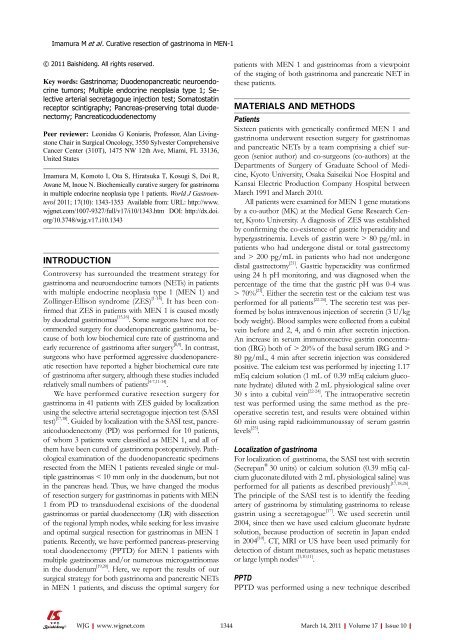10 - World Journal of Gastroenterology
10 - World Journal of Gastroenterology
10 - World Journal of Gastroenterology
Create successful ePaper yourself
Turn your PDF publications into a flip-book with our unique Google optimized e-Paper software.
Imamura M et al . Curative resection <strong>of</strong> gastrinoma in MEN-1<br />
© 2011 Baishideng. All rights reserved.<br />
Key words: Gastrinoma; Duodenopancreatic neuroendocrine<br />
tumors; Multiple endocrine neoplasia type 1; Selective<br />
arterial secretagogue injection test; Somatostatin<br />
receptor scintigraphy; Pancreas-preserving total duodenectomy;<br />
Pancreaticoduodenectomy<br />
Peer reviewer: Leonidas G Koniaris, Pr<strong>of</strong>essor, Alan Livingstone<br />
Chair in Surgical Oncology, 3550 Sylvester Comprehensive<br />
Cancer Center (3<strong>10</strong>T), 1475 NW 12th Ave, Miami, FL 33136,<br />
United States<br />
Imamura M, Komoto I, Ota S, Hiratsuka T, Kosugi S, Doi R,<br />
Awane M, Inoue N. Biochemically curative surgery for gastrinoma<br />
in multiple endocrine neoplasia type 1 patients. <strong>World</strong> J Gastroenterol<br />
2011; 17(<strong>10</strong>): 1343-1353 Available from: URL: http://www.<br />
wjgnet.com/<strong>10</strong>07-9327/full/v17/i<strong>10</strong>/1343.htm DOI: http://dx.doi.<br />
org/<strong>10</strong>.3748/wjg.v17.i<strong>10</strong>.1343<br />
INTRODUCTION<br />
Controversy has surrounded the treatment strategy for<br />
gastrinoma and neuroendocrine tumors (NETs) in patients<br />
with multiple endocrine neoplasia type 1 (MEN 1) and<br />
Zollinger-Ellison syndrome (ZES) [1-14] . It has been confirmed<br />
that ZES in patients with MEN 1 is caused mostly<br />
by duodenal gastrinomas [15,16] . Some surgeons have not recommended<br />
surgery for duodenopancreatic gastrinoma, because<br />
<strong>of</strong> both low biochemical cure rate <strong>of</strong> gastrinoma and<br />
early recurrence <strong>of</strong> gastrinoma after surgery [8,9] . In contrast,<br />
surgeons who have performed aggressive duodenopancreatic<br />
resection have reported a higher biochemical cure rate<br />
<strong>of</strong> gastrinoma after surgery, although these studies included<br />
relatively small numbers <strong>of</strong> patients [4-7,11-14] .<br />
We have performed curative resection surgery for<br />
gastrinoma in 41 patients with ZES guided by localization<br />
using the selective arterial secretagogue injection test (SASI<br />
test) [17,18] . Guided by localization with the SASI test, pancreaticoduodenectomy<br />
(PD) was performed for <strong>10</strong> patients,<br />
<strong>of</strong> whom 3 patients were classified as MEN 1, and all <strong>of</strong><br />
them have been cured <strong>of</strong> gastrinoma postoperatively. Pathological<br />
examination <strong>of</strong> the duodenopancreatic specimens<br />
resected from the MEN 1 patients revealed single or multiple<br />
gastrinomas < <strong>10</strong> mm only in the duodenum, but not<br />
in the pancreas head. Thus, we have changed the modus<br />
<strong>of</strong> resection surgery for gastrinomas in patients with MEN<br />
1 from PD to transduodenal excisions <strong>of</strong> the duodenal<br />
gastrinomas or partial duodenectomy (LR) with dissection<br />
<strong>of</strong> the regional lymph nodes, while seeking for less invasive<br />
and optimal surgical resection for gastrinomas in MEN 1<br />
patients. Recently, we have performed pancreas-preserving<br />
total duodenectomy (PPTD) for MEN 1 patients with<br />
multiple gastrinomas and/or numerous microgastrinomas<br />
in the duodenum [19,20] . Here, we report the results <strong>of</strong> our<br />
surgical strategy for both gastrinoma and pancreatic NETs<br />
in MEN 1 patients, and discuss the optimal surgery for<br />
patients with MEN 1 and gastrinomas from a viewpoint<br />
<strong>of</strong> the staging <strong>of</strong> both gastrinoma and pancreatic NET in<br />
these patients.<br />
MATERIALS AND METHODS<br />
Patients<br />
Sixteen patients with genetically confirmed MEN 1 and<br />
gastrinoma underwent resection surgery for gastrinomas<br />
and pancreatic NETs by a team comprising a chief surgeon<br />
(senior author) and co-surgeons (co-authors) at the<br />
Departments <strong>of</strong> Surgery <strong>of</strong> Graduate School <strong>of</strong> Medicine,<br />
Kyoto University, Osaka Saiseikai Noe Hospital and<br />
Kansai Electric Production Company Hospital between<br />
March 1991 and March 20<strong>10</strong>.<br />
All patients were examined for MEN 1 gene mutations<br />
by a co-author (MK) at the Medical Gene Research Center,<br />
Kyoto University. A diagnosis <strong>of</strong> ZES was established<br />
by confirming the co-existence <strong>of</strong> gastric hyperacidity and<br />
hypergastrinemia. Levels <strong>of</strong> gastrin were > 80 pg/mL in<br />
patients who had undergone distal or total gastrectomy<br />
and > 200 pg/mL in patients who had not undergone<br />
distal gastrectomy [21] . Gastric hyperacidity was confirmed<br />
using 24 h pH monitoring, and was diagnosed when the<br />
percentage <strong>of</strong> the time that the gastric pH was 0-4 was<br />
> 70% [21] . Either the secretin test or the calcium test was<br />
performed for all patients [22-24] . The secretin test was performed<br />
by bolus intravenous injection <strong>of</strong> secretin (3 U/kg<br />
body weight). Blood samples were collected from a cubital<br />
vein before and 2, 4, and 6 min after secretin injection.<br />
An increase in serum immunoreactive gastrin concentration<br />
(IRG) both <strong>of</strong> > 20% <strong>of</strong> the basal serum IRG and ><br />
80 pg/mL, 4 min after secretin injection was considered<br />
positive. The calcium test was performed by injecting 1.17<br />
mEq calcium solution (1 mL <strong>of</strong> 0.39 mEq calcium gluconate<br />
hydrate) diluted with 2 mL physiological saline over<br />
30 s into a cubital vein [22-24] . The intraoperative secretin<br />
test was performed using the same method as the preoperative<br />
secretin test, and results were obtained within<br />
60 min using rapid radioimmunoassay <strong>of</strong> serum gastrin<br />
levels [25] .<br />
Localization <strong>of</strong> gastrinoma<br />
For localization <strong>of</strong> gastrinoma, the SASI test with secretin<br />
(Secrepan ® 30 units) or calcium solution (0.39 mEq calcium<br />
gluconate diluted with 2 mL physiological saline) was<br />
performed for all patients as described previously [17,18,26] .<br />
The principle <strong>of</strong> the SASI test is to identify the feeding<br />
artery <strong>of</strong> gastrinoma by stimulating gastrinoma to release<br />
gastrin using a secretagogue [17] . We used secretin until<br />
2004, since then we have used calcium gluconate hydrate<br />
solution, because production <strong>of</strong> secretin in Japan ended<br />
in 2004 [<strong>10</strong>] . CT, MRI or US have been used primarily for<br />
detection <strong>of</strong> distant metastases, such as hepatic metastases<br />
or large lymph nodes [1,<strong>10</strong>,11] .<br />
PPTD<br />
PPTD was performed using a new technique described<br />
WJG|www.wjgnet.com<br />
1344 March 14, 2011|Volume 17|Issue <strong>10</strong>|

















